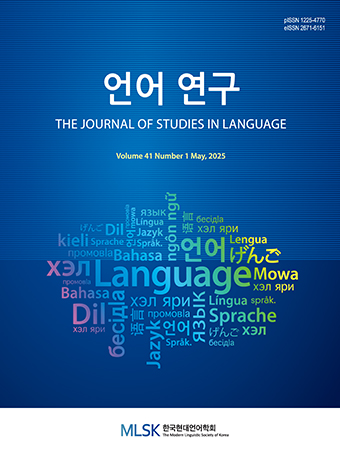Research Article
Abstract
References
Information
This study aims to analyze the use of rhetorical devices in advertising texts based on relevance theory. When interpreting the rhetorical devices in advertising texts using relevance theory, it is important to consider the relevance of words or structures within the context, allowing the audience to understand the speaker’s intention. Additionally, relevance theory suggests that rhetorical devices in texts are based on the audience’s ability to infer relevance, meaning that the most relevant interpretation of the message is explored based on the audience’s background knowledge and context. The implicit meaning of advertising texts can have different meanings depending on the contextual information they are interpreted in, even with the same vocabulary.
- 양정연, 이상철. 2022. 영어 광고에서 형용사 ‘good’과 상황 의미 (ad hoc concept). 언어연구, 38.1, 7-19.
- Austin, L. L. and Gaither, B. M. 2016. Examining public Response to Corporate Social Initiative Types: A Quantitative Content Analysis of Coca-Cola’s Social Media. Social Marketing Quarterly 22.4, 290-306. 10.1177/1524500416642441
- Carston, R. 1996. Metaphor, Irony, and the Psychology of language. Cambridge: Academic Press.
- Carston, R. 2002. Thoughts and Utterances: The Pragmatics of Explicit Communication. New Jersey: Blackwell Publishers. 10.1002/9780470754603 11964277
- Donnelly, C. M. and McDaniel, M. A. 1993. Use of analogy in learning scientific concepts. Journal of Experimental Psychology: Learning, Memory, and Cognition 19.4, 975-987. 10.1037/0278-7393.19.4.975 8345330
- Forceville, C. 1996. Pictorial Metaphor in Advertising. Psychology Press. 10.4324/9780203272305 8916814
- Gibbs, R. W. and Moise, J. F. 1997. Pragmatics in Understanding What is said. Cognition 62.1, 51-74. 10.1016/S0010-0277(96)00724-X 8997170
- Jefkins, F. 1984. Advertising (4th ed.). Macmillan.
- Kövecses, Z. 2000. Metaphor and Emotion: Language, Culture, and Body in Human Feeling. Cambridge University Press.
- Lakoff, G. and Johnson, M. 1980. Metaphors We Live by. Chicago: University of Chicago Press.
- Littlemore, J. 2015. Metonymy. Cambridge: Cambridge University Press. 10.1017/CBO9781107338814
- Martin, J. R. 1992. English Text: Structure and System. Philadelphia: John Benjamin. 10.1075/z.59
- McQuarrie, E. F. and Mick, D. G. 1999. Visual Rhetoric in Advertising: Text-interpretive, Experimental, and Reader- response Analyses. Journal of Consumer Research 26.1, 37-54. 10.1086/209549
- Moriarty, S., Mitchell, N., and Wells, W. D. 2019. Advertising: Principles and Practice (10th ed.). London: Pearson.
- Sperber, D. and Wilson, D. 1995. Relevance: Communication and Cognition (2nd ed.). Oxford: Blackwell.
- Taskiran, N. O. 2018. Metaphor in Advertising: A Relevance Theory Approach. Journal of Language and Linguistic Studies 14.1, 97-108.
- Wilson, D. and Sperber, D. 2002. Truthfulness and Relevance. Mind 111.441, 583-632. 10.1093/mind/111.443.583
- Zaltman, G. and Coulter, R. H. 1995. Seeing the Voice of the Customer: Metaphor-based Advertising Research. Journal of Advertising Research 35.4, 35-51.
- Publisher :The Modern Linguistic Society of Korea
- Publisher(Ko) :한국현대언어학회
- Journal Title :The Journal of Studies in Language
- Journal Title(Ko) :언어연구
- Volume : 39
- No :1
- Pages :23-40
- DOI :https://doi.org/10.18627/jslg.39.1.202305.23




 The Journal of Studies in Language
The Journal of Studies in Language






